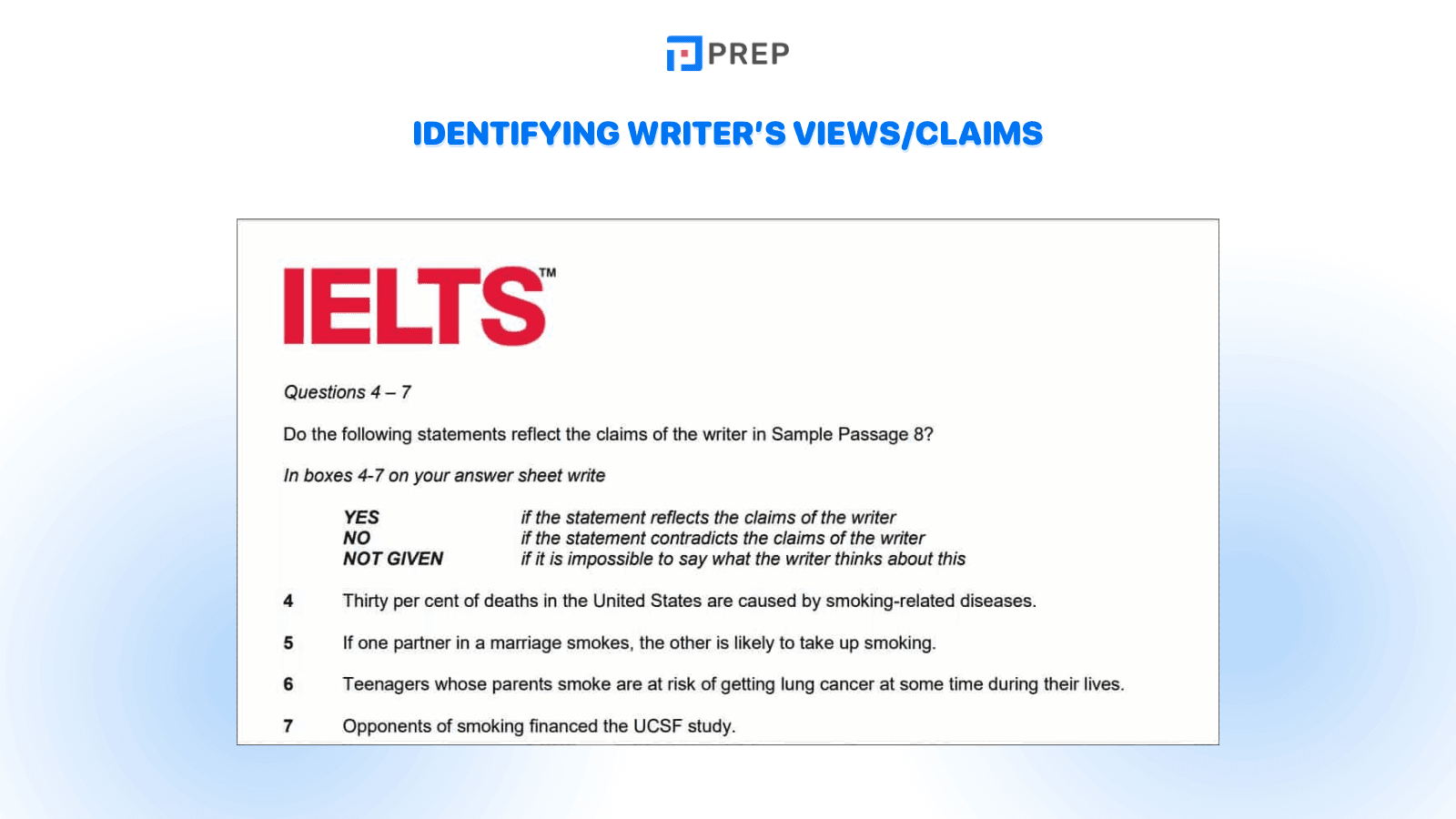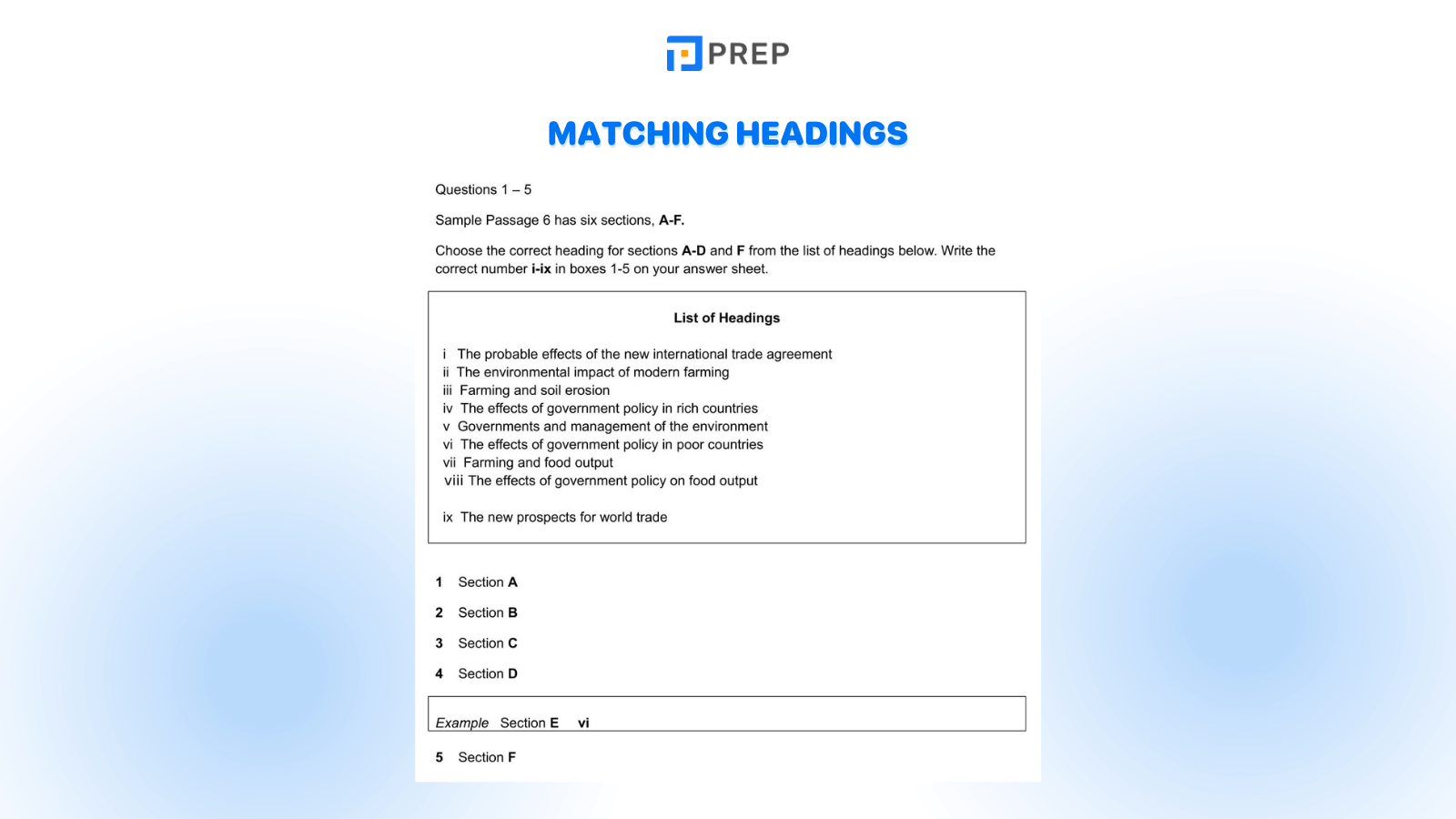11 most common IELTS Reading Question Types
According to the structure of the IELTS Reading test, there will be a total of 40 questions and 3 passages that candidates need to read to answer the questions. The 40 questions are divided into 11 common question types in IELTS Reading. Therefore, when you understand the structure as well as the strategies to tackle these question types, you can save time in answering the questions and achieve a high IELTS band score.
How many types of questions in IELTS Reading are there? In this article, PREP would like to share with Preppies the 11 most common IELTS Reading Question Types. Let's refer to the article together!
- I. Multiple Choice Questions
- II. Identifying information
- III. Identifying writer’s views/claims
- IV. Matching information
- V. Matching headings
- VI. Matching features
- VII. Matching sentence endings
- VIII. Sentence completion
- IX. Summary, note, table, flow-chart completion
- X. Diagram label completion
- XI. Short-answer questions
- XII. Master IELTS Like a Pro

I. Multiple Choice Questions
This is one of the common types of questions in IELTS Reading. Test takers will be asked to select the most appropriate answer from 4 alternative options (A, B, C, or D), or 2 correct answers from 5 alternative options (A, B, C, D, or E), or 3 correct answers from 7 alternative options (A, B, C, D, E, F, or G).

You will have to write the letter of the chosen answer on the answer sheet. The questions may involve completing a sentence, where they are provided with the first part of the sentence and then select the best way to complete the sentence from the options, or they may be complete questions.
The questions follow the order of information in the text, meaning that the answer to the first question in a group will be found in the text before the answer to the second question, and so on. The Multiple-choice format tests a range of reading skills, including a detailed understanding of specific points or an overall understanding of the main points of the text.
Please refer to the following article:
II. Identifying information
This is among the different types of IELTS Reading questions. Test takers will be presented with a set of questions and will be asked the following: "Do the following statements agree with the information in the text?" Then, you will be required to write the answer as 'true', 'false', or 'not given' on the answer sheet.
The difference between "false" and "not given": FALSE - the passage contradicts the statement mentioned; NOT GIVEN - it means the statement is not confirmed or contradicted by the information in the passage.

One thing to note is that any external knowledge you bring from outside the passage, such as everyday life, will not play a significant role in determining the answer. You must stick to the information provided in the passage.
The Identifying Information question type assesses the ability of test takers to recognize specific elements of information conveyed in the text.
Please refer to the following article:
III. Identifying writer’s views/claims
This is among the most common IELTS Reading Question Types. Test takers will be given a set of statements and will be asked: "Do the following statements agree with the views/claims of the writer?" You are required to answer 'yes', 'no', or 'not given' on the answer sheet.
It is important to understand the difference between 'NO' and 'NOT GIVEN'. NO means the writer's viewpoint or statement completely disagrees with the question, indicating that the writer expresses a viewpoint or makes a statement contrary to the viewpoint presented in the question; NOT GIVEN - the viewpoint or claim is not confirmed or contradicted.

One thing to note is that any external knowledge you bring from outside the passage, such as everyday life, will not play a significant role in determining the answer. You must stick to the information provided in the passage.
The Identifying writer's views/claims question type assesses the ability to recognize the test taker's understanding of the writer's viewpoint or ideas and is often used with argumentative or persuasive texts.
IV. Matching information
Candidates participating in the test will be required to find specific information in passages A, B, C, etc. You may be asked to find specific details, examples, reasons, descriptions, comparisons, summaries, or explanations. It is not necessary to find information in every paragraph/section of the text, but there may be more than one piece of information that the test taker needs to find in a specific paragraph/section.

In this case, you will be informed that they may use any letter more than once. The Matching Information question type tests multiple reading skills, from locating specific details to identifying summaries or definitions.
Please refer to the following article:
V. Matching headings
This is among the most common IELTS Reading Question Types. Test takers will be provided with a list of headings, usually identified by lowercase Roman numerals (i, ii, iii, etc.). A heading will refer to the main idea of a paragraph or section of the text. The test taker must match the headings to the correct paragraphs or sections, marked in alphabetical order.

There will always be more headings than paragraphs/sections in the reading, so some headings will not be used. It is also possible that some paragraphs/sections in the reading may not be included in the questions. One or more paragraphs/sections may have been matched with a heading to serve as an example for the test taker.
The Matching Headings question type tests the ability of the candidate to recognize the main idea or topic in paragraphs/sections of the text and distinguish main ideas from supporting ideas.
Please refer to the following article:
VI. Matching features
Candidates are required to match a set of statements or snippets of information with a list of options. The options are a group of features from the text and are identified by letters. Some options may not be used, and other options may be used more than once.

The Matching Features question type assesses the candidate's ability to recognize relationships and connections between events in the text, as well as their ability to identify opinions and theories. The test taker needs to have the ability to skim and scan the text to find the necessary information and read it in detail.
VII. Matching sentence endings
Candidates are given the first half of a sentence based on the text and are asked to select the best way to complete that sentence from a list of possible options. You will have more options to choose from than there are questions. The test taker must write the letter of their chosen option on the answer sheet. The questions follow the order of information in the passage: meaning, the answer to the first question in this group will be found before the answer to the second question, etc.

The Matching Sentence Endings question type assesses the candidate's ability to understand the main idea in a sentence.
VIII. Sentence completion
This is among the most common IELTS Academic Reading question types. Candidates are required to fill in the answer in the blank, and the answer is specified with a certain number of words, for example: 'ONE WORD ONLY' or 'NO MORE THAN TWO WORDS'. If candidates write more words than required, they will lose points. The answer can be written in numerical or written form.

The questions follow the order of information in the passage, meaning the answer to the first question in this group will be found before the answer to the second question, etc. The Sentence Completion question type assesses the candidate's ability to identify specific/detailed information.
Please refer to the following article:
IX. Summary, note, table, flow-chart completion
Candidates are provided with a summary of a section of the text and are asked to complete it with information extracted from the text. The summary is usually only a part of the passage rather than the entire passage.
The information provided may be in the form of a set of connected sentences (referred to as a summary), some notes, a table with some blank cells or a partially blank cell (referred to as a table), a series of boxes or steps connected by arrows to show a sequence of events, with some boxes or steps blank or partially blank (referred to as a flow-chart).

Remember to pay attention to the requirement: "NO MORE THAN THREE WORDS AND/OR A NUMBER."
There are two types of tasks:
- Type 1: You must use vocabulary from the passage to fill in the blanks. You are not allowed to use your language.
- Type 2: Occasionally, the test will provide you with a list of answers. You must read and understand the passage and use the given vocabulary to fill in the blanks.
X. Diagram label completion
This is among the most common IELTS Reading Question Types. Candidates are required to complete labels on a diagram, related to the descriptions in the text. The instructions will specify how many words/numbers the candidates should use in their answers, for example: 'NO MORE THAN THREE WORDS AND/OR A NUMBER from the passage', 'ONE WORD ONLY', or 'NO MORE THAN TWO WORDS'.

If candidates write more words than required, they will lose points. Numbers can be written in numerical or written form. Hyphenated words are counted as one word. The answers do not necessarily have to occur in the order presented in the passage. However, they often come from a specific part rather than the entire text.
The diagram can represent various types of machinery, or parts of a building, or any other element that can be depicted in an image. This type of task is often used with texts describing processes or with descriptive texts.
The Diagram Label Completion question type assesses the candidate's ability to understand detailed descriptions and relate them to information presented in the form of a diagram.
XI. Short-answer questions
This is among the most common IELTS Reading Question Types. Candidates answer questions, usually related to factual information about details in the text. This is often used with a text containing multiple factual and detailed information.
Candidates must write their answers in words or numbers on the answer sheet. Candidates must use words from the text to write their answers. The instructions will specify how many words/numbers the candidates should use in their answers, for example: 'NO MORE THAN THREE WORDS AND/OR A NUMBER from the passage', 'ONE WORD ONLY', or 'NO MORE THAN TWO WORDS'. If candidates write more words than required, they will lose points.

Numbers can be written in numerical or written form. Contracted words are not tested. Hyphenated words are counted as one word. The questions follow the order of information in the text. The Short-Answer Questions question type assesses the candidate's ability to locate and understand accurate information in the text.
For further reference, please read the article:
XII. Master IELTS Like a Pro
This article has provided complete information about the 11 IELTS Reading Question Types. If you’re aiming for IELTS excellence, explore these top-notch resources designed for high achievers below:
- IELTS preparation course: Master IELTS With Us!

Hi I'm Chloe, and I am currently serving as an Product Content Administrator at Prep Education. With over five years of experience in independent online IELTS study and exam preparation, I am confident in my ability to support learners in achieving their highest possible scores.
Comment
Premium content
View allPersonalized roadmap
Most read












